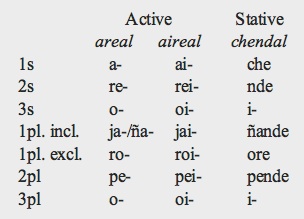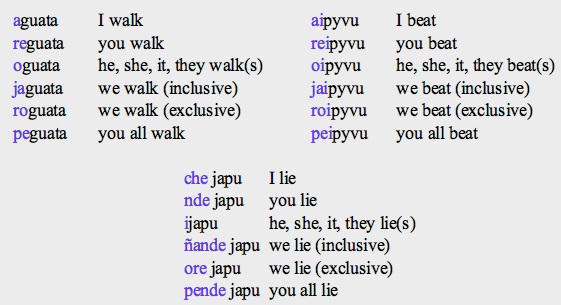An insatiable appetite for ancient and modern tongues


Classification and Overview. Guarani is a native language of the Amazonian lowlands of South America that has become one of the two national languages of Paraguay. It is part of the Tupian family, probably related to Cariban and Macro-Jê families, spoken in scattered areas from south of the Amazon River to southernmost Brazil and Paraguay, and from the Andes Mountains to the Atlantic Ocean. Tupian is divided into seven to ten subgroups, the largest of which is Tupí-Guarani, named for the two most prominent languages at the time of the European colonization: Tupinamba and Guarani. The first one was widely spoken in the coast of Brazil but became extinct in the eighteen century not before leaving hundreds of geographical, animal and plant names. In contrast, Guarani experienced the unique fate of transcending its Amerindian origins to become the mother tongue of the majority of the population of Paraguay, regardless of their Indian or mixed background. This strong position of Guarani in Paraguay is related to the policies of the Jesuit missionaries during the 17th and 18th centuries.
Guarani and Spanish have mutually influenced each other and the former has borrowed many words form the latter. The sound system of Guarani is distinguished by nasal vowels, nasalized consonants and nasal harmony. Its morphology is agglutinative, employing both prefixes and suffixes to mark grammatical features. Its verbal system is characterized by the contrast between active and stative verbs, and word order is a flexible subject-verb-object.
Distribution. Guarani is spoken in South America in the basin of the Paraguay and Paraná rivers, in Paraguay, Argentina (Corrientes, Misiones) and Brazil (Mato Grosso do Sul, Paraná). Guarani Boliviano or Chiriguano is a language closely related to Guarani, spoken in Bolivia.
Speakers. More than 6 million Paraguayans, representing 90 % of the population of Paraguay, speak Guarani. A further 200,000 speak it in Argentina and 6,000 in Brazil. About 40,000 people speak Chiriguano in Bolivia.
Status. In Paraguay it is one of the two official languages of the country (the other is Spanish). The vast majority of Paraguayans is bilingual in Guarani and Spanish. Guarani is a minority language in Corrientes and Misiones in Argentina, and in Mato Grosso do Sul and Paraná in Brazil. It is a second official language of the Argentine province of Corrientes since 2004; it is also an official language of Mercosur (‘Southern Common Market’).
Varieties. Jopará is a colloquial variety, heavily influenced by Spanish, widely spoken in Paraguay. Tribal groups, such as Chiripá, Mbyá and Pai-Tavytera, speak more conservative varieties. Chiriguano is a dialect of (or an independent language closely related to) Guarani, spoken in Bolivia.
Oldest Document. It is the first grammar of Guarani, written in 1640 by the Jesuit Antonio Ruiz de Montoya.
Phonology
Syllable structure: Guarani only allows syllables consisting of a vowel or a consonant plus a vowel; syllables ending in a consonant or two or more consonants together are not possible.
Vowels (12). It has six oral and six nasal vowels:

Consonants (17-23). All voiced stops (and the single affricate) are prenasalized and are pronounced as such only before oral vowels. Before nasal vowels they become nasal consonants. Thus, prenasalized stops and nasal consonants are allophones. The palatal affricate and nasal are also allophones. The dorsal fricative (articulated with the mid-body of the tongue) is in free variation between [x] and [h]. The glottal stop is only written between vowels, but also occurs phonetically before vowel-initial words. The rhotic (r-sound) is a flap; a trill is found only in Spanish loanwords.

Nasal harmony. The nasality of a stressed nasal vowel or of a nasal consonant spreads to the left of it covering the root and the prefixes.
Stress. Roots have generally final stress.
Script and Orthography. A standard orthography for Guarani was agreed at the Montevideo Congress in 1950. The script has 33 characters. It is based on the Latin-derived script used for Spanish but includes a number of additional digraphs and diacritics to indicate nasal sounds. In contrast, it omits several letters used in Spanish (b, c, f, etc) that are not required in Guarani. Below each letter, its correspondence in the International Phonetic Alphabet is shown between brackets.

-
•The labio-velars are represented as follows: [kʷ] by ku, [ŋgʷ] by ngu, [ŋʷ] by g̃u.
-
•nt is only present in the suffixes nte and ntese, and in a few proper names and borrowed words.
-
•rr is a rolled r-sound found in some Spanish loanwords and onomatopoeic words.
Morphology
Guarani morphology is agglutinative employing prefixes and suffixes to provide grammatical information. Nominal roots are marked mainly by suffixes. In the verb system, prefixes serve to indicate person and number (of the subject and of the object) while tense, aspect, mood and derivation use either prefixes or suffixes. Nominalization and subordination are marked by suffixes. Guarani has no definite article.
-
Nominal. Nouns are marked for case, number and possession but not for gender. Adjectives do not exist as a separate category.
-
•case: is indicated by suffixes, postpositions or a combination of both. Case markers tend to merge with pronouns or pronominal prefixes into special forms. -pe is used to mark a direct or indirect object, and also as a locative marker; -gui is an ablative suffix (equivalent to ‘from’) while -ndi(ve) is a comitative one (indicates company). Subject and inanimate objects are not marked.
-
jagua o-juka mbarakaja-pe
-
dog S3s-kill cat-OD
-
The dog kills the cat.
-
-
a-ju Paraguay-gui
-
S1s-be Paraguay-ABL
-
I am from Paraguay.
-
i-po-pe-kuera
-
POSS-hand-LOC-PL
-
In his hands.
-
•number: singular, plural. Plural is marked with the suffix -kuera (-nguera after a nasal vowel):
-
jagua (dog) → jaguakuera (dogs)
-
mitã (child) → mitãnguera (children)
-
Diminutive and collective are also indicated by suffixes.
-
•pronouns: personal, demonstrative, interrogative.
-
Personal pronouns have subject, possessive, direct object and indirect object forms. They distinguish first plural inclusive from exclusive. Possessive pronouns are placed before the noun.

-
Demonstrative pronouns recognize at least four deictic degrees (from proximal to distal): ko, pe, amo, ku (and their plural forms).
-
The interrogative pronouns are avapa (‘who?’) and mba'epa (‘what?’).
-
•possession: is indicated by possessive pronouns placed before the noun or by juxtaposition of two nouns in the order possessor-possessed:
-
che kavaju (my horse)
-
tuva sombrero (father's hat)
-
Verbal. Guarani has an active/stative system: transitive verbs are active but intransitive verbs can be active or stative. The active verbs or "areals" use prefixes as subject markers (the "aireal" verbs are a variant), while the stative or "chendal" verbs use independent subject pronouns.

-
•person and number: person of subject is indicated by prefixes in areal and aireal conjugations but by separate pronouns in chendal verbs (except 3rd person that uses a special prefix). The names of the three verb types derive from the 1st + 2nd singular forms. First person plural distinguish between inclusive and exclusive. Subject markers are shown in the table.
-
•tense-aspect: present, progressive, remote past, perfect, imminent future, future.
-
The present has no tense marker, it can also function as a near past. The remote past is marked by the suffix -va'ekue, the imminent future with -ta and a non-imminent future with the suffix -va'erã. A progressive tense is indicated by the suffix -hina.
-
Below, are the present conjugations of the areal verb guata, the aireal verb pyvu, and the chendal verb japu.

-
•mood: indicative, subjunctive, imperative. Subjunctive and imperative are marked by prefixes.
-
•derivative conjugation: causative, reflexive, reciprocal, desiderative They are indicated by prefixes except causative of transitive stems and desiderative that are marked by suffixes. Causative of transitive verbs -(u)ka, causative of intransitive verbs mbo-, reflexive je-, reciprocal jo-, desiderative -se.
-
•negation: is indicated by a combination of prefix and suffix (circumfix): nd- … -i. This negation marker can be used in all tenses, but for future or irrealis reference, the normal tense marking is replaced by mo'ã, resulting in n(d)(V)-base-mo'ã-i as in Nd-a-japo-mo'ã-i, "I won't do it".
Syntax
Guarani word order is a rather flexible Subject-Verb-Object. Adjectives follow nouns. Grammatical relations, except subject and inanimate object, are indicated by case markers, postpositions, or combinations of both. First and second person object pronouns precede the verb but third person forms follow it.
Basic Vocabulary
one: peteĩ
two: mokõi
three: mbohapy
four: irundy
five: po
six: poteĩ
seven: pokõi
eight: poapy, poapyha, ocho (from Spanish),
nine: porundy
ten: pa
hundred: sa
father: pa'i, ru, tuva, taita
mother: sy
brother: kyvy
man's older brother: ryke'y
man's younger brother: ryvy
woman's older sister: ryke
sister (of a man): reindy
son: ra'a, ta'yra
son or daughter of a woman: memby
head: akã
face: tĩcha'ĩ, jurukechẽ
eye: tesa, resa
hand: avatisoka
foot: mby
heart: ñe'a, py'a
tongue: kũ
Key Literary Works (forthcoming)
-
© 2013 Alejandro Gutman and Beatriz Avanzati
Further Reading
-
-The Amazonian Languages. R. M.W. Dixon & A.Y. Aikhenvald (eds). Cambridge University Press (1999).
-
-A Description of Colloquial Guarani. E. Gregores & J. A.Suárez. Mouton (1967).
-
-Gramática Guarani. N. Krivoshein de Canese & F. Acosta Alcaraz. Servilibro (2001).
-
-'Guarani'. W. F. H. Adelaar. In Concise Encyclopedia of Languages of the World, 467-468. K. Brown & S. Ogilvie (eds). Elsevier (2009).
Guarani

Address comments and questions to: gutman37@yahoo.com
MAIN LANGUAGE FAMILIES
LANGUAGE AREAS
Languages of Ethiopia & Eritrea
LANGUAGES by COUNTRY
LANGUAGE MAPS
-
• America
-
• Asia
-
Countries & Regions
-
-
Families
-
• Europe
-
• Oceania